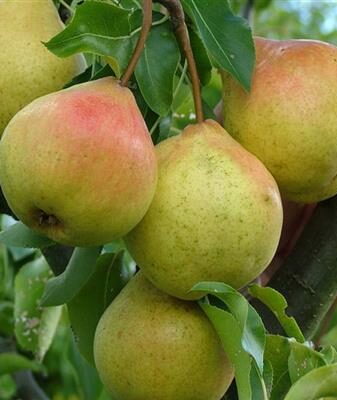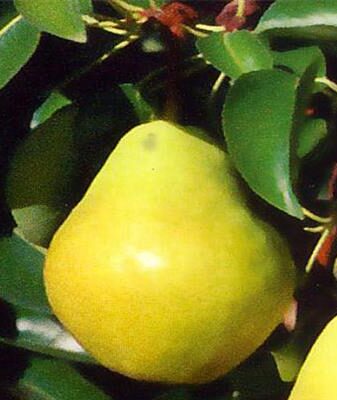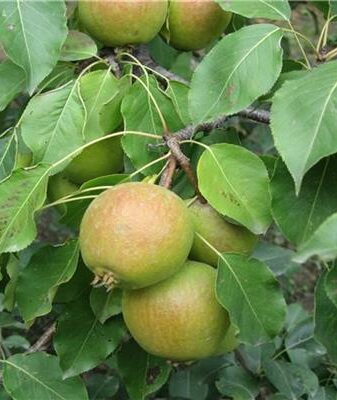Pear Dessert
Content:
Dessert pear is valued for its particular simplicity in care, these trees are fast-growing, the harvest is always rich, and the fruits are very fragrant and tasty. However, in order to grow this tree on your personal plot, you need to know about the rules of growing, so carefully study the presented article.
This pear variety was bred in the last century, the full name of the plant is Dessert Rossoshanskaya pear. As you understand, Russian scientists were engaged in selection. Crossing late-ripening and Belgian pears resulted in a new unusual variety that can be grown in different regions of our country. It is best to plant these trees in the Central Black Earth Region, as well as in the North Caucasus.
Dessert pear: description of the variety and characteristics
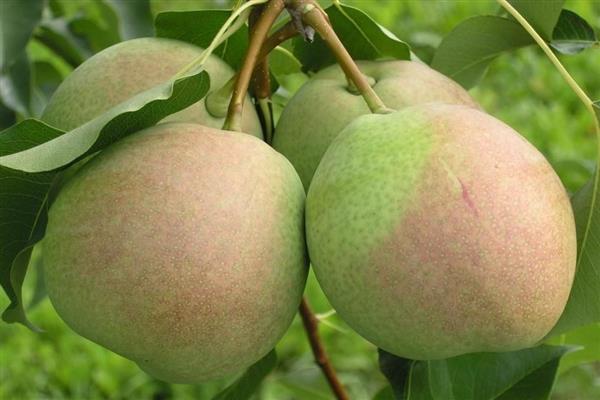
Pear Dessert Rossoshanskaya: photo of the variety
Dessertnaya Rossoshanskaya pear trees are quite tall, because they grow up to 5-6 m in height. The crown is broad-pyramidal in shape, but the shoots are sparse, the leaves of the plants are green, slightly twisted at the tips. The leaf plates are oval in shape, and medium in size. The inflorescences on the pear are always very beautiful, snow-white, the flowers themselves are quite large, with pink blotches, double, cupped. In each umbellate inflorescence, usually no more than 9 flowers are formed. Their petals are always quite even, the inflorescences are tightly located on the stem. The pear also begins to bear fruit early enough. Fruit is always tasty and healthy. The mass of one pear usually varies between 100-150 g. However, individual specimens are larger, the weight of one fruit can even be more than 200 g.
If we talk about the shape of the fruit, then the fruits are round, pear-shaped or apple-shaped, sometimes quite flat. The peel of the variety of pears Dessert Rossoshanskaya is smooth, not rusty, when the fruits ripen, they turn light yellow, a beautiful pink blush is usually noticeable on the surface. Large subcutaneous points are also scattered over the pears. They come in both gray and green. The peduncles of pears are medium, curved. The flesh of the Dessert pear is tasty and aromatic, either creamy or white. It is believed that these pears are not sour, so the taste is always consistently sweet.
Dessertnaya Rossoshanskaya pear usually begins to bear fruit in the fall. The plant also always blooms magnificently, abundantly. For the first time, fruits are formed on a tree at the age of five. It is believed that these trees begin to bloom early enough when compared with valuable varieties. If we talk about harvesting, then everything depends on the specific growing conditions. For example, in the southern regions, pears are harvested at the end of summer, and in mid-latitudes - a little later, in the fall. The yield is always consistently high, experienced gardeners collect more than 60 kg of ripe and aromatic pears from one tree. However, it is worth noting that this plant is not self-fertile, so there must be pollinator neighbors nearby, otherwise you will not collect any harvest from the tree. It is important to ensure that the neighbors bloom at the same time, so consider this factor when choosing a pollinator. But it is not necessary that the dessert pears should grow on your site. So, it is quite possible to do with neighboring landings.
Dessert pear: advantages and disadvantages
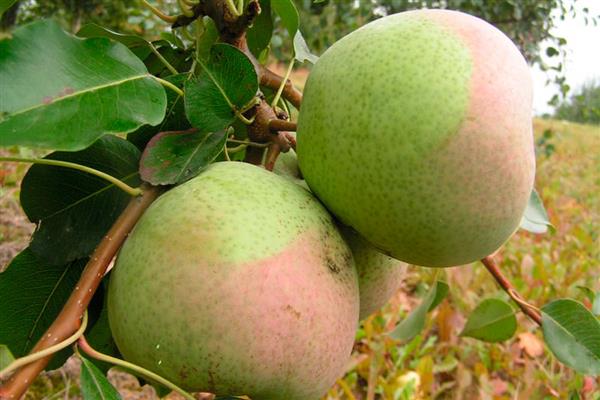
Pear Dessert Rossoshanskaya: photo of the variety
The dessert pear, like any other variety, has its advantages and disadvantages. If we talk about the benefits, then it should be noted: Dessertnaya Rossoshanskaya pear is not demanding on the composition of the soil, it bears fruit early, intensively, annually. The yield is always also consistently high, as you remember, more than 60 kg of fruit can be harvested from one plant. Plant immunity is also good; the pear can withstand many adverse weather events. Fruits can be transported over long distances, fruits are stored for a long time, do not deteriorate. The fruit's commercial and taste qualities are excellent, the product is also versatile, pears can be consumed fresh or processed.
However, despite all this, this variety has its own limitations... The main one is self-infertility. As you know, this means that pollinators must grow nearby, otherwise the Rossoshanskaya Dessert pear will not give you fruit. Another disadvantage is that the trees are not very frost-resistant. Prolonged spring frosts negatively affect flowering, already at -2 degrees the flowers begin to freeze and die, therefore it is quite dangerous to grow this pear in the northern regions.
Pear Dessert: planting varieties
Before planting the Rossoshanskaya Dessert pear, you must definitely choose the right place. This variety does not like drafts and wind, so it is better to plant a pear near any fences, in a well-lit area. If we talk about the composition of the soil, then these trees are not demanding on it, however, it is better to choose fertile soil, this plant feels good on loam. If you are on solid ground, the plant may die. If we talk about the acidity of the soil, it is better to plant trees in a neutral environment. It is undesirable to lime the soil. There should also be no excess moisture on the site, therefore, groundwater should not lie close to the earth's surface. The root system of the pear is quite voluminous and long, therefore, an excess of water in the ground adversely affects the development of the plant. Oxygen must also be supplied to the roots, therefore experienced gardeners recommend often loosen the trunk circle. It is best to buy pear seedlings in a specialized store, nursery, so that the planting material does not disappoint you.
Before planting the Dessertnaya Rossoshanskaya pear variety, it is advisable to cut the roots and shoots. The planting pit is also prepared in advance. In depth, it should be at least 1 m, and in diameter - up to 70 cm. Usually compost, humus, various fertilizers and organic matter are added to the planting hole. In order for the soil to become well structured, you can add some wood ash and sand to the soil. The lower part of the pit is loosened. Then a mound is formed under the root system of the seedling. The soil must be compacted well, and the roots must be straightened. The neck of the tree should be located above the ground. It is recommended to pour at least 20 liters of water into each planting pit. In order to prevent moisture from evaporating in the future, it is better to mulch the trunk circle; for this, peat, straw and humus are often used.
Pear Dessert: variety care

Pear Dessert Rossoshanskaya: photo of the variety
In order to grow a Dessert Pear, you need to properly water the plants, cut them off and apply fertilizers to the soil in a timely manner. These are the main criteria for caring for this culture. It is imperative to water the trees in a timely manner, since pears do not tolerate drought well. However, from an excess of moisture, the root system also begins to rot, so the dosage must be observed in everything. If you moisten the soil too much, the plant may even shed its foliage, so be careful. Watered pear variety Dessertnaya Rossoshanskaya from the following calculation: 3 liters per square meter, it is recommended to water the plant especially intensively during the formation of ovaries, ripening of fruits. However, even after harvesting, plants need moisture; in late autumn, it is recommended to carry out water-charging irrigation.
Dessert pears are pruned not very often, since the crown of plants is rare. Therefore, up to the age of three, the shoots can not be touched at all. Do not forget to carry out sanitary pruning in early spring, form a crown. When the pear begins to bear fruit, only the largest shoots are recommended to be cut. All old, deformed and diseased branches must also be removed.
Fertilizer is applied to the soil several times per season. Previously, it was recommended to close organic matter into the trunk circle. Ammonium nitrate is often used for this. It is nitrogen-containing fertilizers that help the plant to build up green mass, so they need to be embedded in the soil in early spring. In summer and autumn, it is better to use complex mineral dressings. It is recommended to add potassium sulfate, superphosphate and manure to the soil.
Do not forget to properly prepare the trees for wintering. In late autumn, you can whitewash the trunk of the pear in order to protect the plants from certain diseases. Plants are protected from rodents and hares with a net or roofing material. But it is not necessary to shelter adult pears from frost. But young plants do not tolerate frost well, so it is better to wrap the tree trunk. To do this, use paper, spunbond, any breathable material. The trunk circle is recommended to be mulched, for this they use dry earth, sawdust. Remember that this layer must be thick enough to protect the plants from frost.
Pests and diseases
As you remember, the Desertnaya Rossoshanskaya pear variety has good immunity, so it rarely gets sick. Insects also practically do not attack plants, but some pests still like to feast on the foliage and shoots of this tree. Often in the crown of a tree you can find winter span, she herself is not very dangerous, but the larvae gnaw out flowers, shoots, and leaves. This caterpillar leaves only streaks, and destroys everything else. It is best to collect pests by hand, and also to destroy insect nests. Moss from plants must be cleaned, and the stamp must be whitened.
If you notice that green pears began to fall off and rot, then this means that the tree has settled moth... It is also recommended to collect this pest by hand, and burn the affected fruits. Remember to dig up the soil near the trunk.
If you see yellow spots on the skin of the fruit, which over time began to grow, then these are most likely signs of the appearance on the plant pear sawfly. The fruits on the tree begin to rot and fall off, and the flesh of pears becomes whitish, soft and loose. This disease is intensively spreading throughout the site, so all diseased pears must be collected and destroyed. Trees are treated with a solution of Bordeaux liquid, over time the concentration is reduced. Sometimes, in especially dangerous cases, growths even appear on the surface of the leaves. The foliage falls off over time. In order to cure an infected tree, you need to treat it with Bordeaux liquid. Be sure to collect and burn all diseased leaves, and loosen the soil of the trunk circle.
Features of the fruit
As you remember, Dessert Rossoshansky pears are stored for a long time, so you can easily transfer the fruits over long distances. However, for this, it is advisable to pick the pears unripe. In ripe pears, the color is yellow, and the blush is pinkish, they are stored until the end of autumn, and sometimes until January. You need to pick pears with your hands, it is advisable to tear off each fruit along with the stalk. Shaking the trees is undesirable, since when falling on pears, various defects and damage appear, which means that they will not be stored for a short time. Therefore, it is advisable to harvest the crop by hand. Dessert pears are put in containers or boxes, stored in dark places, basements. Layers of pears are shifted in a box with paper or sawdust. The peduncles are recommended to be guided diagonally. Sometimes each row is sprinkled with sand.So the variety of pear Dessertnaya Rossoshanskaya will be stored for a long time, and you will delight yourself with ripe and aromatic products until the end of autumn, and maybe until the New Year.


